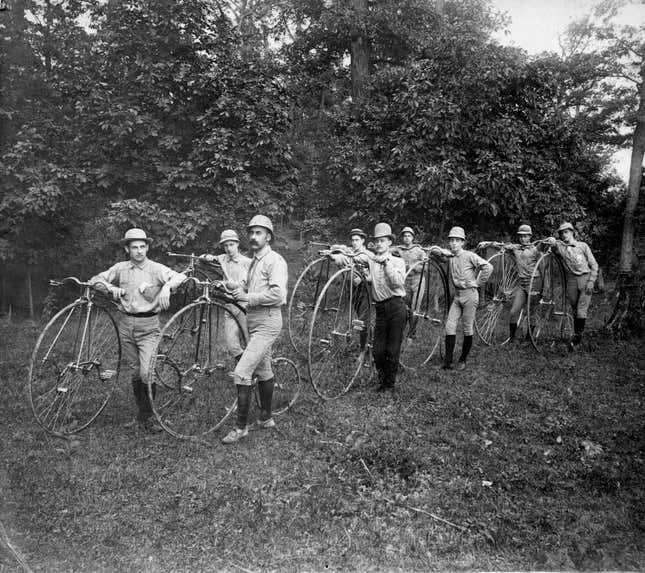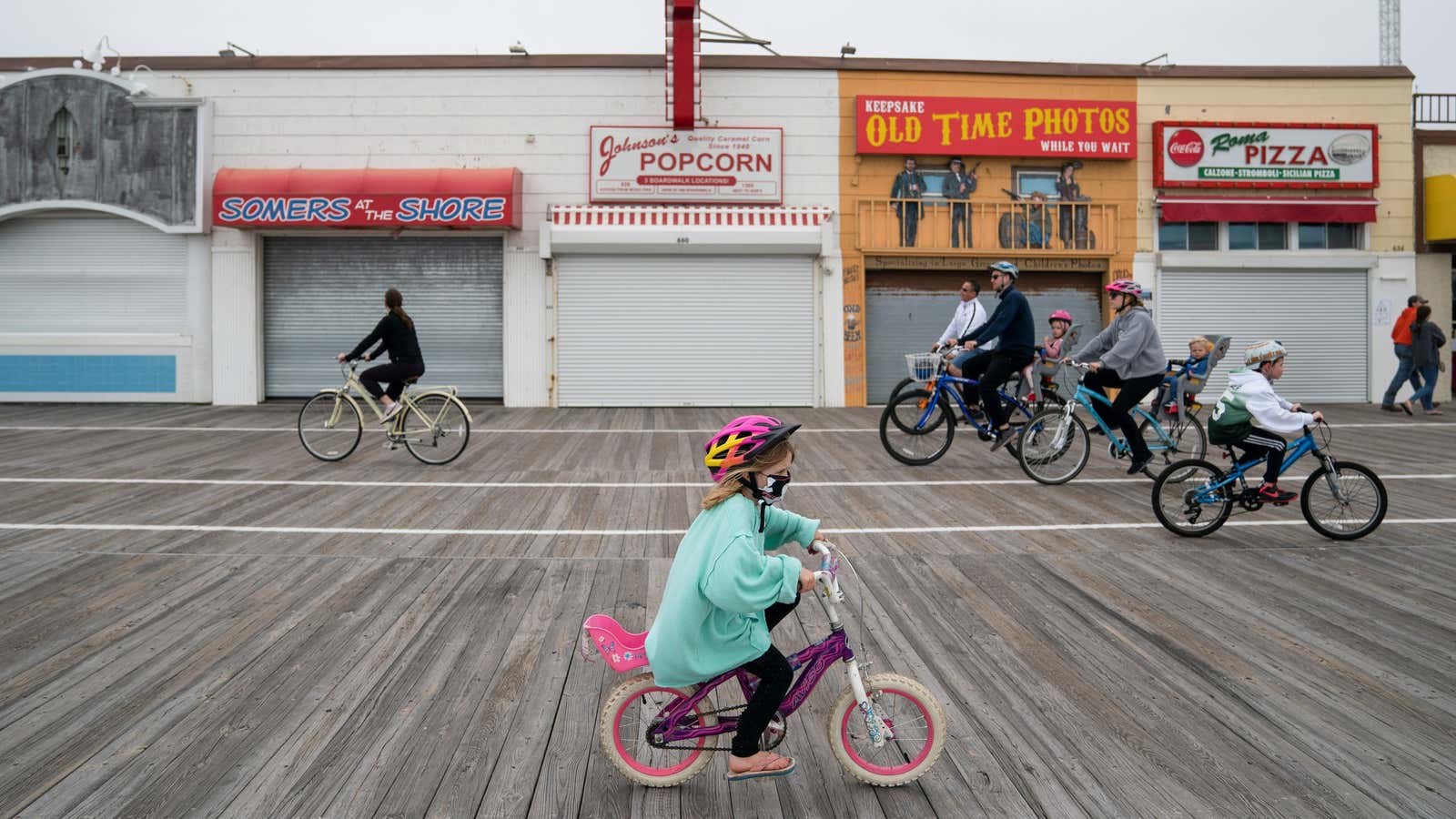Michael Coleman hardly picked up his bike since leaving Washington DC for Austin, Texas in 2018. For months, it lay nearly abandoned in the garage.
Then the coronavirus pandemic hit.
With a two-year-old daughter at home, and nowhere to go, Coleman bought a metallic-green hybrid bike with a child seat at the local bike shop. Coleman and his daughter have pedaled through Austin and bike trails winding into the rocky hills around the city almost every day since then. His daughter loves it.
“We’ve been logging the miles week-in and week-out,” says Coleman, who works as a communications strategist for the nonprofit Public Citizen. “I’d estimate well over 100 miles since this began in March … It’s been a real life-saver, and a mood-saver.”
Coleman is not alone, and you might have noticed. Thousands of people are getting back on their bikes after an extended hiatus: Appointments to tune up old rides are booked weeks into the future. Bicycle trips on trails across the US rose 57% throughout March and April compared to 2019, according to the Rails-to-Trails Conservancy.
There are new converts, too. Bikes under $1,000 have been almost impossible to keep in stock. REI, a national outdoor gear store, said it is selling four times as much cycling equipment as the same time last year, including adult bikes, kids’ bikes, and accessories. “We do not expect sales to slow down in the near term, as long as supply can keep up,” wrote REI merchandising manager Ron Thompsen by email.
But supplies are stretched thin. Most bikes are manufactured in Asia, and the coronavirus shutdown slowed production just as sales picked up. Across the US, market research firm NPD reports sales of bicycles and shop services shot up to $733 million in March, a 44% jump over last year. Families and fitness fans are the biggest buyers: Sales of recreational bikes rose 121% to nearly 250,000 in March, while stationary exercise bikes and indoor stands nearly tripled to about 200,000 units.
Far from a modest blip, this bicycle boom may have staying power. It’s the third great bicycle boom in American history, and it’s poised to reconfigure the layout of American cities.
Can it last?
Biking in the US first peaked in the 1890s (pdf). A new “safety” bicycle design (with two equally sized wheels, a more stable design than the penny-farthing high-wheelers) made it attractive to the masses. Dedicated bicycle highways were built in New Jersey and New York, and bicycle races competed with baseball in popularity.
One observer recalled an America in which almost everyone—businessmen and grandparents alike—rode bikes daily: “The great avenues of our larger cities were made extremely picturesque in the dusk of evening by the endless line of bicyclists whose lanterns in the darkness produced the vivid effect of a river of coloured fire.”

The craze lasted through an economic depression, only to be supplanted by the internal combustion engine. But interest spiked again between 1965 and 1975 as faster, cheaper multi-speed bikes hit the market. Millions resumed pedaling. The rush on new bikes prompted a bicycle shortage, not unlike today. At its height, more bikes were being sold than cars each year, prompting Time in 1971 to designate the era “bicycle’s biggest wave of popularity in its 154-year history.”
But that fervor faded too as the Baby Boomer generation lost interest. Today, most Americans don’t bike. Those that do ride just a few times per year. The advocacy group PeopleForBikes reports in an April 2019 survey that only 32% of Americans (pdf) older than three had ridden a bicycle in the last year. Among those regular riders, just about 12% had ridden within the last four months. In just a generation, bikes had become a neglected hobby.
American cities on a roll
Yet this time biking is more than just a pastime. The coronavirus has made bikes essential.
Although data about the likelihood of transit-based coronavirus transmission is still thin, the public is worried about entering a subway car or bus. Public transit agencies, meanwhile, must contend with operating the system while maintaining social distance restrictions. In London, officials estimate its network can operate at just 15% capacity. So people are opting out of public transit for bikes and cars.
“We are seeing evidence that in cities opening back up, commuters returning to work are shunning public transportation and increasingly relying on shared bikes,” says Asad Hussain, a mobility analyst for private equity research firm PitchBook.
Many cities have responded by facilitating cycling and walking. London’s mayor Sadiq Khan said the city will ban cars on many city streets, creating one of the largest such zones in the world. Brussels rapidly repurposed car lanes for bikes, then made those changes permanent. France is dedicating more than 400 miles of cycling lanes throughout the Paris metropolitan area, and spending €20 million ($21.9 million) to subsidize bike repairs, install temporary bike racks, and offer cycling courses.
In America, the path is less certain, says PitchBook’s Assad. In Europe and Asia, where car ownership is less common, a shift toward shared mobility—ride hailing and shared fleets of bikes and scooters—is underway. But the United States’ penchant for cars, extensive automobile infrastructure, and relatively cheap prices means personal car ownership is likely to increase in the short term.
Some American cities are pushing hard against that trend. Oakland has closed 74 miles of city streets, around 10% of its total, to through traffic. It plans to expand its “slow streets” initiative, a concept spreading to Portland, Boston, Minneapolis, Washington DC and elsewhere, reports CityLab. New York has turned to bikes as an essential alternative to its subways: 12,000 critical workers have been using free memberships on Lyft’s Citi Bike program, and the company says weekend ridership is approaching record levels again after hitting 80,000 rides on May 16, not far from its 100,000-ride peak last year.
But for biking to truly be a viable alternative in the US, it has to be safer. Beyond accessing a functional bicycle (only half of Americans have one), aspiring bikers’ top concern is personal safety and protection from cars. Prioritizing bikers means building dedicated infrastructure, says Augustin Wegscheider who leads the Boston Consulting Group’s mobility practice. “If you just add more bikes, and the infrastructure is the same, you’re not going to get behavioral change,” said Wegscheider. Case studies in New York showed bike lane upgrades increased ridership by women by more than 40% in 2019.
The pandemic has created the largest urban transportation experiment in a generation. With many streets reclaimed, at least temporarily, by bicyclists and pedestrians, they may be safer for cyclists than at any time in modern history. In New York City, collisions with bicyclists fell to 113 in April, down 62% compared to the same month last year—and half the rate seen in 2013, previously the lowest on record (data only go back to 2012).
Whether bicycles resume their place at the heart of American city life depends on what cities do next.
Warren Logan, director of mobility policy and interagency relations in the Oakland mayor’s office, says that the city’s slow streets initiative merely gave people the opportunity to reclaim public space once occupied by vehicles. Unlike most traffic programs that cost millions of dollars, the price tag for closing 74 miles of streets was almost nothing: some street barricades, staff time, and printed signs Logan estimated cost less than $1,000.
“What we did was not that much,” he said. “We just reminded people they deserve slow streets and they already told us which streets were already slow and safe. We delivered on something we already said we were going to deliver. We just sped it up.”
Clarification: This story has been updated to note the bicycle Michael Coleman used with a child seat was a new hybrid, not a road bike and corrects the spelling of Augustin Wegscheider of Boston Consulting Group.
